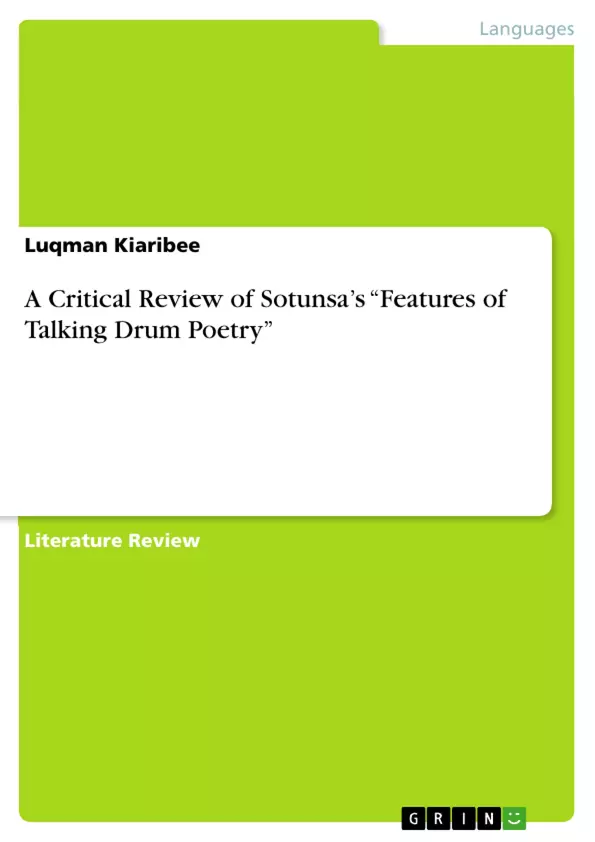This paper critically reviews Sotunsa’s (2005) “Features of Talking Drum Poetry,” a doctoral thesis submitted to the English Department, Faculty of Arts, University of Ibadan. To present this paper in a simpler form an attempt has been made to divide it into sections.
Section one discusses the introduction which is the background to the paper, while section two (the abstract) discusses the paper’s goals. The third section covers the summary of the thesis. Section four as well is a critical review of affirmations made by the author.
We considered some scholars’ views on these affirmations and looked at their genuineness. We made assumptions to rectify some views likewise we made comment to credit the genuineness of author’s arguments where it is necessary. In the last section, we do the summary and make some recommendations in support of author’s arguments established in the last chapter of the thesis.
Our goal, in this paper, is to do a constructive criticism on Sotunsa’s doctoral thesis basically, it is for academic purposes.
Inhaltsverzeichnis (Table of Contents)
- Abstract
- Introduction
- The Summary of the Thesis
- The Critical Analysis of Findings and Affirmations in Sotunsa (2005); Features of Talking Drum Poetry
- Conclusion
- References
Zielsetzung und Themenschwerpunkte (Objectives and Key Themes)
This paper critically reviews Sotunsa's (2005) doctoral thesis, "Features of Talking Drum Poetry," aiming to provide a constructive analysis for academic purposes. The paper explores the unique stylistic features and aesthetic functionality of talking drum poetry within the context of Yoruba oral poetry.
- The significance of traditional oral poetry as a distinct art form.
- The unique stylistic attributes and aesthetic functionality of talking drum poetry.
- The role of the talking drum in Yoruba oral poetry and its relationship to other modes of oral expression.
- The application of semiological approach, functionalism, ethno-musicology and communication theories in analyzing talking drum poetry.
- The stylistic features of Yoruba drum poetry, including rhythmic and intonation patterning, musicality, variation in pitch, pauses, vowel clustering, gliding, rhythmic elongation, and ambiguity.
Zusammenfassung der Kapitel (Chapter Summaries)
- Chapter 1: Discusses the argument for considering traditional oral poetry as a distinct art form, citing various scholars. Explores the place of the talking drum in Yoruba oral poetry and reviews different perspectives on its status. Introduces the theoretical framework of the study, including semiological approach, functionalism, ethno-musicology and communication theories.
- Chapter 2: Reviews previous related works on the nature, forms, functions, and importance of drum poetry, citing scholars like Adetoyese Laoye, Echezona, Euba, Adegbite, Ajayi, and Esinlokun.
- Chapter 3: Explores the unique style and aesthetic functionality of Yoruba drum poetry, emphasizing its membronic verbal communication nature. Analyzes stylistic features such as rhythmic and intonation patterning, musicality, variation in pitch, pauses, vowel clustering, gliding, rhythmic elongation, and ambiguity. Provides examples of drum poetry texts and their analysis.
Schlüsselwörter (Keywords)
This paper focuses on the key concepts of Yoruba oral poetry, talking drum poetry, stylistic features, aesthetic functionality, semiological approach, functionalism, ethno-musicology, communication theories, and membronic verbal communication. The analysis of Sotunsa's work provides insights into the unique qualities and significance of this art form.
- Arbeit zitieren
- Luqman Kiaribee (Autor:in), 2015, A Critical Review of Sotunsa’s “Features of Talking Drum Poetry”, München, GRIN Verlag, https://www.hausarbeiten.de/document/343777


